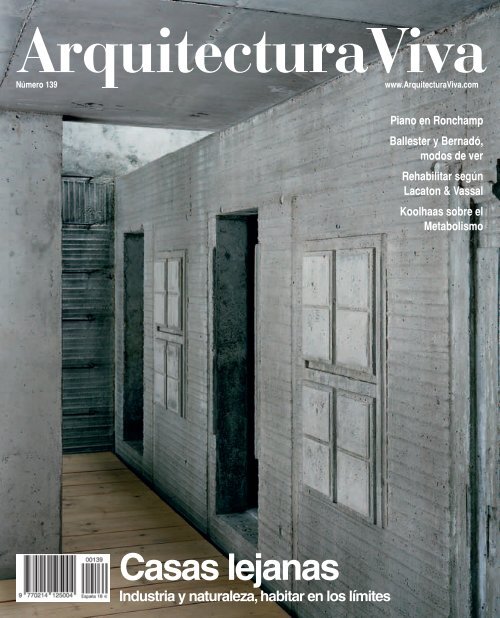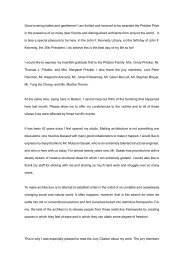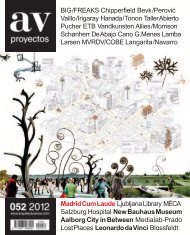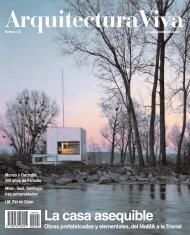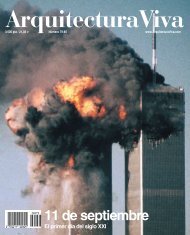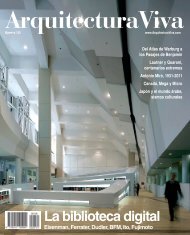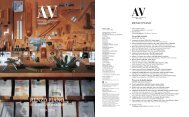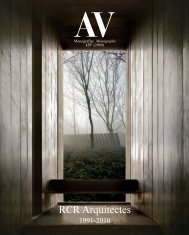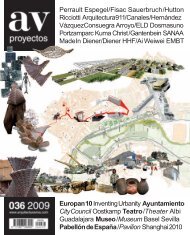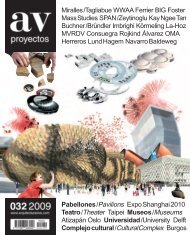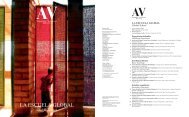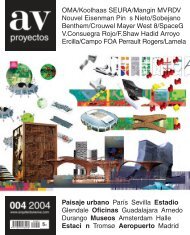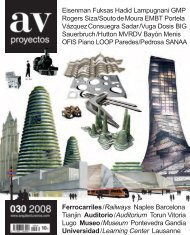Casas lejanas - Arquitectura Viva
Casas lejanas - Arquitectura Viva
Casas lejanas - Arquitectura Viva
- No tags were found...
Create successful ePaper yourself
Turn your PDF publications into a flip-book with our unique Google optimized e-Paper software.
<strong>Arquitectura</strong><strong>Viva</strong>Número 139www.<strong>Arquitectura</strong><strong>Viva</strong>.comPiano en RonchampBallester y Bernadó,modos de verRehabilitar segúnLacaton & VassalKoolhaas sobre elMetabolismo<strong>Casas</strong> <strong>lejanas</strong>Industria y naturaleza, habitar en los límites
<strong>Arquitectura</strong><strong>Viva</strong>.comNúmero 139DirectorLuis Fernández-GalianoDirector adjuntoJosé Jaime S. YusteDiagramación y redacciónCuca FloresLuis JátivaRaquel CongostoLaura FernándezEduardo PrietoLys VillalbaPablo del SerMaite BáguenaDavid CárdenasCoordinación editorialLaura MulasGina CariñoProducciónLaura GonzálezJesús PascualAdministraciónFrancisco SolerSuscripcionesLola GonzálezDistribuciónMar RodríguezPublicidadCecilia RodríguezRaquel VázquezRedacción y administración<strong>Arquitectura</strong> <strong>Viva</strong> SLAniceto Marinas, 32E-28008 MadridTel: (+34) 915 487 317Fax: (+34) 915 488 191AV@<strong>Arquitectura</strong><strong>Viva</strong>.comwww.<strong>Arquitectura</strong><strong>Viva</strong>.comPrecio: 18 euros© <strong>Arquitectura</strong> <strong>Viva</strong>Esta revista ha recibido una ayuda de la DirecciónGeneral del Libro, Archivos y Bibliotecas delMinisterio de Cultura para su difusión en bibliotecas,centros culturales y universidades de España para latotalidad de los números del año.Depósito legal: M. 17.043/1988ISSN: 0214-1256Distribución en quioscos: CoedisImpresión: Artes Gráficas Palermo, S.L.Cubierta: Casa Hutznhaisl en Sajonia,de AFF architekten.Foto: Hans-Christian Schink.Traducciones: L. Játiva (Koolhaas), E. Prieto (Ingersoll,Williams); L. Mulas (inglés).<strong>Casas</strong> <strong>lejanas</strong>. La casa fue el laboratorio donde la modernidad ensayó sushipótesis, desde la apuesta por la seriación hasta el anhelo de volver a la Arcadia.Esta hibridación entre la industria y la naturaleza es el argumento compartidopor una familia de casas que cubren tres décadas de investigación. El refugioalpino de Perriand (1937), la Packaged House de Wachsmann (1941), la WichitaHouse de Fuller (1944), la Maison Tropicale de Prouvé (1949), la Casa Engstromde Erskine (1955) o la Casa Moduli 225 de Gullichsen/Pallasmaa (1969) sonejemplos que siguen siendo modelos de eficacia tipológica y medioambiental.Obras / ProyectosHabitar en los límites. Las casas <strong>lejanas</strong> lo son por estar emplazadas enentornos remotos pero también por proponer una manera de habitar distinta a laconvencional. Tales son las características de un conjunto de doce ejemplos detodo el mundo, que se han agrupado en tres familias. La primera está formadapor cuatro casas ubicadas en Japón, Australia y Chile, que tienen en común suempleo de soluciones ligeras e industrializadas; la segunda da cuenta de otroscuatro ejemplos de Portugal, Colombia, Costa Rica y Ecuador, cuya característicacompartida es el recurso a las tradiciones constructivas locales; por suparte, la tercera y última recoge nuevos tipos edificatorios asociados a diferentesemplazamientos, climas y soluciones constructivas.Arte / CulturaPaisajes sagrados. Las intervenciones arquitectónicas y artísticas llevadasa cabo en la singular Ruta del Peregrino, en México, coinciden con la recienteinauguración de la ampliación de Ronchamp, de Renzo Piano.Fronteras del ojo. Dos artículos analizan la mirada de dos de los mejoresfotógrafos de arquitectura en España, y singulares artistas: la austera y poéticade José Manuel Ballester, y la precisa y desenfadada de Jordi Bernadó.El retorno de los metabolistas. Un extracto de Project Japan, el nuevolibro de Rem Koolhaas sobre el Metabolismo japonés, encabeza la sección,acompañado de reseñas sobre obras, fotografía, literatura y recibidos.Técnica / ConstrucciónInnovación en detalle. La singular rehabilitación tipológica y energéticade la torre Bois-le-Prête, un edificio de viviendas situado en París, llevadaa cabo por Lacaton & Vassal y Frédéric Druot, abre la sección dedicada ala innovación tecnológica, en la que se incluye también un artículo sobre larelación creativa entre los arquitectos y los industriales en el desarrollo de loscatálogos de carpinterías, cuarto de una serie de seis sobre la fachada ligera.Además, un texto sobre el cálculo de la huella del carbono en la arquitectura,y un catálogo de productos que presenta novedades en vivienda sostenible,sistemas de geotermia urbana, climatización evaporativa y materiales plásticos.Para terminar, un artículo sobre los principios de diseño desarrolladosa lo largo de su carrera en Apple por el recientemente fallecido Steve Jobs.17 Industria y naturalezaTres décadas de innovación18 Perriand, Refugio alpino20 Wachsmann, Packaged House22 Fuller, Wichita House24 Prouvé, Maison Tropicale26 Erskine, Casa Engstrom28 Gullichsen/Pallasmaa, Casa M.30 Hasegawa, Casa en Karauzawa32 Pritchard, Casa en Adelaida34 Supersudaka, Casa Kiltro36 Radic, Casa A40 Aires Mateus, Casa en Comporta44 Plan:b, Casa en Río Cedro48 García Saxe, Casa en Avellanas52 Al bordE, Casa en Tumbaco54 Pezo v. Ellrichshausen, Casa Cien58 Li Xiaodong, Casa en Lijiang60 Ichiku, Casa Las Cabinas62 AFF, Casa Hutznhaisl67 Miquel AdriáSenderos de arte70 Richard IngersollEcos de Ronchamp74 Francisco J. San MartínLa soledad del espacio76 Ricardo Devesa‘Troppo vero!’78 Historietas de FochoPiano vs. Le Corbusier79 Autores variosLibros88 Lacaton & Vassal / F. DruotRehabilitación en París100 Paricio y PardalInnovación y catálogo103 InnovaciónHuella de carbonoSostenibilidadRenovablesClimatizaciónPlásticos112 Sarah Williams GoldhagenPíxeles con cuerpo
Number 13917 Industry and NatureThree Decades of Innovation18 Perriand, Alpine Shelter20 Wachsmann, Packaged House22 Fuller, Wichita House24 Prouvé, Maison Tropicale26 Erskine, Engstrom House28 Gullichsen/Pallasmaa, M. HouseRemote Houses. The house was the laboratory where modernity tested itshypotheses, from mass production to the yearn for a return to Arcadia. Thisparadoxical hybridization between industry and nature is the argument sharedby a family of houses that cover three decades of innovation. The alpine shelterof Perriand (1937), the Packaged House of Wachsmann (1941), the WichitaHouse of Fuller (1944), the Maison Tropicale of Prouvé (1949), the EngstromHouse of Erskine (1955) or the Moduli 225 House of Gullichsen/Pallasmaa(1969) are still today models of typological and environmental efficiency.Works / Projects30 Hasegawa, House in Karauzawa32 Pritchard, House in Adelaide34 Supersudaka, Kiltro House36 Radic, A House40 Aires Mateus, House in Comporta44 Plan:b, House in Rio Cedro48 García Saxe, House in Avellanas52 Al bordE, House in Tumbaco54 Pezo v. Ellrichshausen, Cien House58 Li Xiaodong, House in Lijiang60 Ichiku, Las Cabinas House62 AFF, Hutznhaisl HouseDwelling on the Edges. Remote houses are considered so because theyare located in faraway places, but also because they propose a way of living thatdeparts from the conventional one. These are the characteristics of the twelvehouses from different parts of the world gathered in this section, and whichhave been grouped into three families. The first family presents four housesin Japan, Australia and Chile, which have in common their use of lightweightand industrialized solutions; the second includes four from Portugal, Colombia,Costa Rica and Ecuador, which all have in common that they recourse to localconstruction traditions; and the third and last takes examples of new buildingtypes linked to different sites, climates and constructive solutions.Art / Culture67 Miquel AdriáArt Paths70 Richard IngersollEchoes of Ronchamp74 Francisco J. San MartínThe Solitude of Space76 Ricardo Devesa‘Troppo vero!’78 Focho’s CartoonPiano vs. Le Corbusier79 Various AuthorsBooks88 Lacaton & Vassal / F. DruotRehabilitation in Paris100 Paricio & PardalInnovation and Catalogue103 InnovationCarbon FootprintSustainabilityRenewablesClimatizationPlastics112 Sarah Williams GoldhagenPixels with BodySacred Landscapes. The architectural and artistic interventions carriedout in the unique Ruta del Peregrino (The Pilgrim Route), in Mexico, coincidewith the recent inauguration of the Ronchamp extension, by Renzo Piano.Frontiers of the Eye. Two articles analyze the gaze of two of the best architecturalphotographers in Spain, also unique artists: the austere and poetic workof José Manuel Ballester, and the precise and carefree one of Jordi Bernadó.The Return of the Metabolists. An excerpt from Project Japan, the newbook by Rem Koolhaas on Japanese Metabolism, heads the section, followed byreviews of works, photography, literature and books received.Technique / ConstructionInnovation in Detail. The unique typological and energetic refurbishmentof the Bois-le-Prête tower, a housing building located in Paris and designed byLacaton & Vassal and Frédéric Druot, opens the section devoted to technologicalinnovation, which also includes an article regarding the creative relationshipbetween architects and industrialists in the development of a variety of frames,the fourth piece in a series of six on lightweight facades. Moreover, a textabout the calculation of the carbon footprint in architecture, and a repertoireof products that presents novelties in sustainable housing, aside from urbangeothermal energy, evaporative climate control and plastic materials.To close, an article on the design principles developed by the recently disappearedSteve Jobs during his career at Apple.
Amores que matanHay amores que matan, y nuestra devoción por la casa es uno de ellos.Cada número dedicado a la casa nos obliga a recitar una retahíla exculpatoria.Sí, sabemos que el hábitat disperso generado por la vivienda unifamiliary por el automóvil que la hace accesible es un disparate ecológico, unatropello paisajístico y un empobrecimiento social: el despilfarro de recursosmateriales y energéticos en su construcción y mantenimiento es una agresióncontra el planeta; la extensión indiscriminada de ese tapiz de baja densidaddegrada irreversiblemente el territorio, y la fragmentación de la vida colectivadestruye la tupida red de contactos que es la principal riqueza de las ciudades,el soporte de su prosperidad y la base de su atractivo. Y sí, también sabemosque en las actuales circunstancias de nuestra civilización, asediada por elcambio climático, el agotamiento de los combustibles fósiles y el desgobiernoeconómico, lo único que cabe preconizar responsablemente es la densidadurbana, al cabo incompatible con la casa.Pero la casa nos fascina y nos seduce, sea en su versión antropológicade cobijo elemental y habitación esencial, sea en su variante tecnológicade escaparate de la vida privada y cofre del confort familiar, y acabamossucumbiendo al embrujo de su encanto. La excusa es así la dimensiónfenomenológica que exploró Gaston Bachelard, con la casa como alberguede los sueños del desván y las pesadillas del sótano, en una línea de pesquisaCase Study californianas de John Entenza con los Eames o Pierre Koenigcomo su momento más eufórico, y el collage del recientemente desaparecidoRichard Hamilton —Just what is it that makes today’s homes so different,so appealing?— como su anuncio y apoteosis pop. Aferrados a esta añagazaen su modelo intemporal o en su encarnación contemporánea, continuamosconstruyendo casas y hablando de ellas.Con todo, la casa sigue siendo un formidable laboratorio de investigacióne innovación que permite sondear los límites de la industria y la naturalezaen los límites, como evidencian tanto los estudios pioneros de fabricaciónresidencial —de los que publicamos seis ejemplos de la historia próxima—como las experiencias extremas de construcción de casas o refugios engeografías remotas —documentadas con una docena de realizacionesrecientes en cuatro continentes—, y esta presentación simultánea ilustraquizá la fertilidad tenaz y permanentemente renovada del experimento de lacasa. Predicaremos pues las bondades de la ciudad densa como el marco másadecuado para la vida humana en un mundo finito, y seguiremos denostandola insensata suburbanización del planeta que promueven el automóvil y lacasa; pero continuaremos consumiendo ésta, en pequeñas dosis, como unaexperiencia arriesgada o placentera: una droga de diseño, una vacuna enpruebas o un veneno que ojalá no mate.Luis Fernández-GalianoThere are loves that kill, and our devotion to thehouse is one of them. Every issue dedicated tohouses forces us to offer a string of excuses. Yes,we know that the scattered habitat generated bythe single-family house and by the car that makes itaccessible is an ecological disaster, a defacementof landscape and a social impoverishment: thesquandering of material and energy resources inits construction and maintenance is an agressionto the planet; the indiscriminate growth of thoselow-density carpets irreversibly deteriorates theterritory; and the fragmentation of collective lifedestroys the dense web of contacts that is the mainwealth of cities, the basis of their prosperity andthe essence of their appeal. And yes, we also knowthat in the current predicament of our civilization,threatened by climate change, the scarcity of fossilfuels and the collapse of governance, only urbandensity, in the end incompatible with the house, canresponsibly be defended.But the house fascinates and seduces us, be it inits anthropological version of elementary shelter andessential dwelling, be it in its technological variantas showcase of private life and space for familycomfort, and we end up surrendering to its spell.The excuse is thus the phenomenological dimensionexplored by Gaston Bachelard, with the house asshelter for the dreams of the attic and the nightmaresof the basement, delving into the subsconsciousalong lines that go from Freud or Lacan to Zizekpassing through Hitchcock; or else the celebrationof modern consumption, with the Case Study housesof John Entenza with the Eames or Pierre Koenigas its most euphoric moment, and the collage ofthe recently disappeared Richard Hamilton – Justso appealing? – as its pop ad and apotheosis.Holding on to this bait in its ageless version or inits contemporary form, we go on building housesand talking about them.All in all, the house is still a fabulous laboratoryfor research and innovation which allows exploringboth the boundaries of industry and nature on itsboundaries, as shown by the pioneering studies ofresidential manufacturing – of which we publishsix examples from recent history – and by theextreme experiences in the construction of housesor shelters in remote places – documented by adozen new works in four continents –, and thissimultaneous presentation perhaps illustrates thestubborn and permanently renewed fertility of thehouse experiment. We will then praise the virtuesof the dense city as the most adequate context forhuman life in a finite world, and keep criticizing thesenseless suburbanization of the planet promotedby the car and the house; but we shall continue toconsume the latter, in small doses, as a risky orpleasurable experience: a designer drug, a vaccineunder study or a poison that we hope does not kill.<strong>Arquitectura</strong><strong>Viva</strong> 139 2011 3


